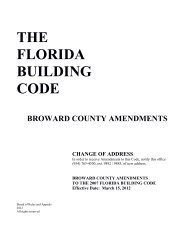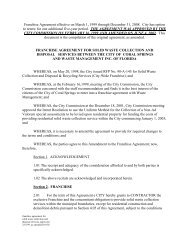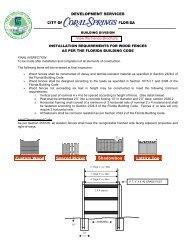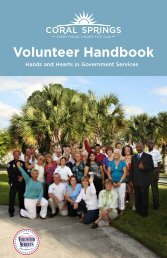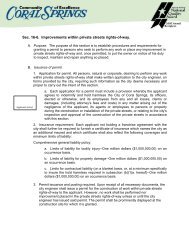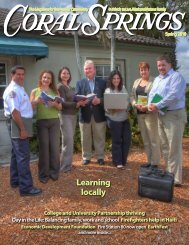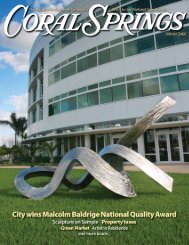Fall 2006 - City of Coral Springs
Fall 2006 - City of Coral Springs
Fall 2006 - City of Coral Springs
You also want an ePaper? Increase the reach of your titles
YUMPU automatically turns print PDFs into web optimized ePapers that Google loves.
Our Water<br />
Where does it come from?<br />
Florida’s local governments are at a crossroads, and their<br />
next steps will have enormous environmental and financial<br />
implications. The South Florida Water Management District<br />
(SFWMD) is limiting the amount <strong>of</strong> water available to<br />
municipalities for drinking water and lawn irrigation because<br />
the majority <strong>of</strong> the water is needed for the Everglades<br />
Restoration Project.<br />
<strong>Coral</strong> <strong>Springs</strong> draws its water from the Biscayne Aquifer,<br />
one <strong>of</strong> the largest and highest quality ground water sources<br />
in the country. The Biscayne Aquifer is located in southeast<br />
Florida and generally extends from Boca Raton through<br />
Homestead and from the Everglades to the Atlantic Ocean.<br />
It is in the cool depths <strong>of</strong> the earth, generally between<br />
110 and 180 feet below ground surface and is constantly<br />
replenished by rainwater, and through canals and lakes that<br />
are operated by the SFWMD. Most cities in South Florida “dip<br />
their straws” into the Biscayne Aquifer, and withdraw a limited<br />
amount <strong>of</strong> water as permitted by the SFWMD.<br />
“According to the new rules that have been established,<br />
the <strong>City</strong> is not allowed to withdraw any additional water<br />
to meet our future growth from the aquifer,” said Utilities<br />
Superintendent Dave Moore. “Unless we demonstrate that it<br />
does not affect the Everglades restoration project.”<br />
The State and Federal Governments have joined forces<br />
to restore the damage that draining the Everglades has<br />
caused over the past century. In December 2000, President<br />
Clinton signed the Water Resources Development Act, which<br />
included the Comprehensive Everglades Restoration Plan<br />
(CERP). CERP is a guide to restore, protect, and preserve the<br />
water resources <strong>of</strong> central and southern Florida. It will take<br />
approximately 30 years to complete the project and will cost<br />
in excess <strong>of</strong> $7.8 billion. The Everglades Restoration Project<br />
is affecting everyone in South Florida, as SFWMD is asking<br />
Utility Divisions to not pull additional water from the Biscayne<br />
Aquifer and use alternative water supplies.<br />
<strong>Coral</strong> <strong>Springs</strong> has four different utilities that supply water<br />
and wastewater services to residents: the <strong>City</strong>-operated<br />
<strong>Coral</strong> <strong>Springs</strong> Utilities Division and the independentlyoperated<br />
<strong>Coral</strong> <strong>Springs</strong> Improvement District, North <strong>Springs</strong><br />
Improvement District and Royal Utilities.<br />
The <strong>City</strong> <strong>of</strong> <strong>Coral</strong> <strong>Springs</strong> Utilities Division, which serves<br />
the central part <strong>of</strong> the <strong>City</strong>, operates a water treatment plant<br />
that prepares the water for drinking and other potable and<br />
irrigation uses. Nineteen wells are scattered around the<br />
central portion <strong>of</strong> the <strong>City</strong> that draw the water from the<br />
Biscayne Aquifer for further treatment.<br />
The customers <strong>of</strong> the <strong>City</strong>’s Utilities service area consume<br />
an average 7 to 8 million gallons <strong>of</strong> water a day. The water<br />
After water from the Biscayne<br />
Aquifer gushes up from a well in the<br />
<strong>City</strong>, where the water is then put<br />
through many treatment processes<br />
before being delivered to citizens.<br />
plant runs 24 hours a day, seven days a week, and is able<br />
to process up to 16 million gallons <strong>of</strong> water each day.<br />
According to Moore, future redevelopment in <strong>Coral</strong> <strong>Springs</strong><br />
may require an additional 1.5 million gallons a day.<br />
As South Florida’s increasing demand for potable water<br />
continues, several public water utilities have turned to the<br />
Floridan Aquifer, a slightly salty water, which requires a<br />
reverse osmosis treatment process to make the water safe for<br />
drinking. “The Floridan Aquifer requires a completely different<br />
treatment process than what we use now,” said Moore. “It<br />
would cost approximately $13 million to build that treatment<br />
facility and it wouldn’t be a very cost effective solution since<br />
we would only draw 1.5 million gallons a day.”<br />
Another option for additional water supply would be water<br />
reuse, which involves taking domestic wastewater and giving<br />
it a high degree <strong>of</strong> treatment. The water is then used for a<br />
new, beneficial purpose, such as irrigation. Unfortunately,<br />
<strong>Coral</strong> <strong>Springs</strong> does not have the capabilities <strong>of</strong> reusing water<br />
and it would cost millions to put into place.<br />
In May 2008, the <strong>City</strong> will renew its water use permit with<br />
the SFWMD. The <strong>City</strong> will attempt to increase the current<br />
average daily and maximum daily allocations to meet the<br />
expected growing population and is currently in the works <strong>of</strong><br />
establishing their argument.<br />
The cost <strong>of</strong> restoring the Everglades is high and the State<br />
and Federal governments are paying those bills. However,<br />
that is only part <strong>of</strong> the cost and municipalities will be<br />
required to utilize alternative water supplies for urban uses if<br />
their water permits are not increased.<br />
Water is becoming scarce and inexpensive water supplies<br />
can no longer be taken for granted.<br />
This article is the first <strong>of</strong> a series, which will<br />
delve further into water use, the treatment process,<br />
and how you can help by conserving water.<br />
environment<br />
Watch <strong>City</strong>TV Channel 25 <strong>Fall</strong> <strong>2006</strong> • <strong>Coral</strong> <strong>Springs</strong> • 11



